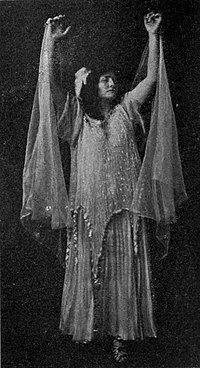Contents
Lou Wall Moore (née Lula Belle Wall; c. 1860–1924) nicknamed "Princess Lou", was an American sculptor, stage actress, costume designer, dancer, and socialite from Chicago.[1][2][3] She was known for early modern dance interpretations of ancient Greek dance, as well as appearing in Grecian plays, and for portraying Salome.[2][4][5] Her sculptures were primarily busts, done in an ancient Greek style.

Early life and education
Lou Wall Moore was born c. 1860 in St. Louis, Missouri,[6] to parents Frances Elizabeth (née Calvert) and Captain Nicholas Wall. Her father was a riverboat captain and a noted steam boatsmen.[7] Her family had moved to Montana Territory around the time she was born, and they remained there until 1876.
Moore attended the Lexington Baptist Female College (around 1878; now part of Wentworth Military Academy and College) in Lexington, Missouri.[8] She continued her education at the School of the Art Institute of Chicago (around 1901), and studied sculpture under Lorado Taft.[9][2]
As sculptor
Moore was particularly focused on creating bust portraits, statuettes, and reliefs.[2] She often sculpted in a Greek-style.[2] Some of her notable bust sculptures included noted pianist, Fannie Bloomfield Zeisler; professor at Northwestern University, James Taft Hatfield; cellist, Paul Kefer; Chauncey Blair's daughters; civil engineer, Ralph Modjeski's son; and stage performer, Valeria Alicia English.[2]
In 1903, Moore served as the vice president of the Art Students League of Chicago.[10] She won an award at the Saint Louis Exposition for her sculpture.[2]
As performer and costume designer
In 1910, Moore was invited to dance in the White House before President Theodore Roosevelt.[11] Around June 1910, Moore had joined the Sylvan Players, and prior to that she had danced with the Ben Greet Players.[2][12]
In June to July 1910, she appeared wearing in tights in a performance of "Les Romanesque" in Bloomington, Illinois; it made front page news in the Chicago Tribune, and caused a "religious war" within the Bloomington community when the Deacon of the Methodist church spoke against her performance.[2][13][14]
Moore appeared in the cast of many productions at the Chicago Little Theatre, many of which were Grecian plays.[11][15] She designed the costumes for The Trojan Women in 1913 held at the Chicago Little Theatre.[16]
She was a co-founder alongside poet Maxwell Bodenheim of “The Shop,” a bohemian social club in Chicago.[17]
Personal life and death
For many years she lived at 5476 Ridgewood Court in Chicago, Illinois.[2] She was married to Albert Wasson Moore in 1880; the marriage ended when he died on February 21, 1915.[18]
She died after battling pneumonia on March 13, 1924, in her home on Ridgewood Court,[11] she was around age 60. She is buried in Bellefontaine Cemetery in St. Louis.
See also
References
- ^ Parry, Albert (2013-06-17). Garrets and Pretenders: Bohemian Life in America from Poe to Kerouac. Courier Corporation. p. 194. ISBN 978-0-486-29046-1.
- ^ a b c d e f g h i j "Who Was Right: The Dancer or the Deacon?". Chicago Tribune. June 26, 1910 – via Newspapers.com.
- ^ "Society Woman Who Will Dance at Suffrage Entertainment and University Girl Participants in Play". The Inter Ocean. March 29, 1910. Retrieved 2023-04-20 – via Newspapers.com.
- ^ Fabens, Hannah E. (1908). "Lou Wall Moore's Interpretation of Ancient Dances". Burr McIntosh Monthly. Vol. 15–17. Burr McIntosh Publishing Company. pp. 334–336.
- ^ "The Rehabilitation of Terpsichore". Current Literature. Vol. 45. Current Literature Publishing Company. 1908. pp. 86–90.
- ^ "Lula Belle Wall". FamilySearch.org. Retrieved 2023-04-20.
- ^ Robison, Ken (April 6, 2022). "Steamboat Bertrand's sinking made ripples in Montana". Helena Independent Record. Retrieved 2023-04-20.
- ^ "Baptist Female College". The Lexington Intelligencer. September 21, 1878. Retrieved 2023-04-20 – via Newspapers.com.
- ^ "The School". Bulletin of the Art Institute of Chicago (1907-1951). 7 (1): 11–13. 1913. ISSN 1935-6595. JSTOR 4120102.
- ^ Catalogue Annual Exhibition of the Art Students League of Chicago; The Ninth Annual Exhibition of the Works of the Art Students League. March 5, 1903.
- ^ a b c "Mrs. Lou Wall Moore Dies; Was Actress, Designer, Too". Chicago Tribune. March 14, 1924. Retrieved 2023-04-20 – via Newspapers.com.
- ^ "Russian Music with Acting". The New York Times. November 17, 1908. p. 9. ISSN 0362-4331. Retrieved 2023-04-20 – via Newspapers.com.
- ^ "Lou Wall Moore to Dance". Chicago Tribune. June 27, 1910. Retrieved 2023-04-20 – via Newspapers.com.
- ^ "Dancer Who Shocked Deacons Says Her Act Was Harmless and Modest". The Times. June 7, 1910. Retrieved 2023-04-20 – via Newspapers.com.
- ^ Hartel, Herbert R. (2011). "Raymond Jonson and the Chicago Little Theatre, 1912-1917: The Influence of the Simple Stage Aesthetic on An American Modernist Painter". Journal of the Illinois State Historical Society. 104 (3): 199–222. doi:10.2307/41228547. ISSN 1522-1067. JSTOR 41228547. S2CID 140950268.
- ^ "Trojan Women (1913) | APGRD". Archive of Performances of Greek and Roman Drama (APGRD). University of Oxford. Retrieved 2023-04-20.
- ^ Geigner, Megan E.; Hecht, Stuart J.; Mahmoud, Jasmine Jamillah (2021-07-15). Makeshift Chicago Stages: A Century of Theater and Performance. Northwestern University Press. p. 79. ISBN 978-0-8101-4383-8.
- ^ "Obituary for Albert W. Moore". St. Louis Post-Dispatch. February 23, 1915. Retrieved 2023-04-20 – via Newspapers.com.
External links
- Image of "Lorado Taft with costumed group" (1897; it has Moore in photo) from the University of Illinois Archives

